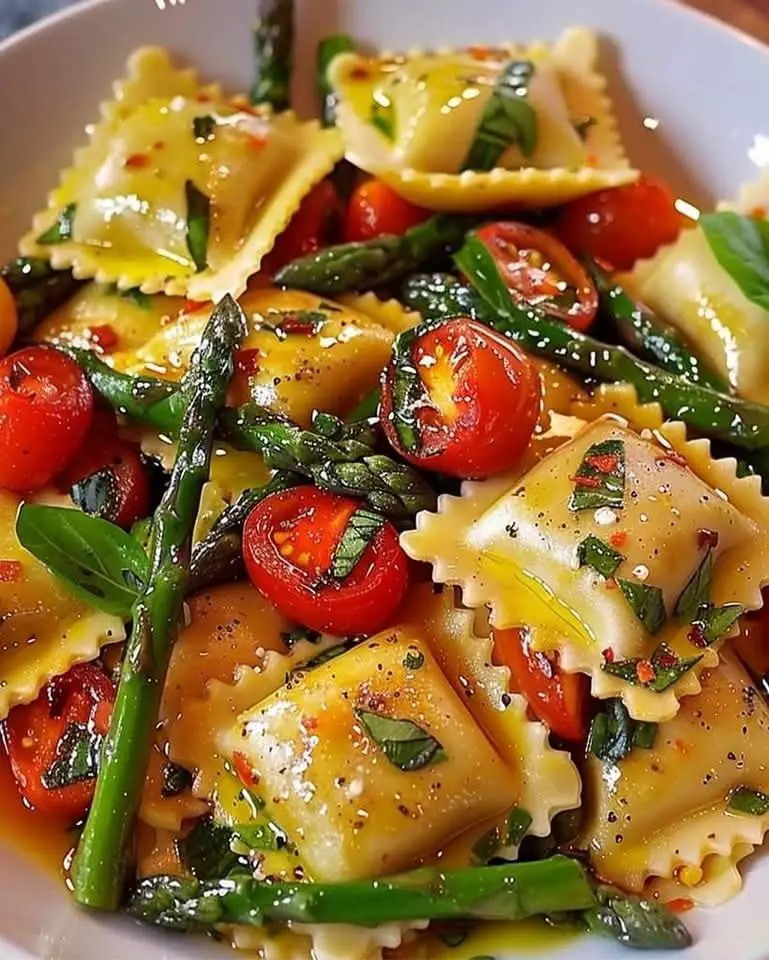Ravioli with Tomatoes, Asparagus, Garlic, and Herbs: A Delightful Italian Dish
Imagine a plate of tender ravioli, filled with a creamy mixture, bathed in a savory sauce of fresh tomatoes, vibrant asparagus, aromatic garlic, and a sprinkle of fresh herbs. Whether you are hosting a fancy dinner party or enjoying a cozy meal for two, this Ravioli with Tomatoes, Asparagus, Garlic, and Herbs offers a perfect blend of flavor and fragrance, capturing the essence of a classic Italian dish. The pasta’s delicate texture combines with the zesty sauce to provide a culinary experience that is both satisfying and heartwarming.
Quick Recipe Highlights
– Flavor Profile: The Ravioli with Tomatoes, Asparagus, Garlic, and Herbs is savory and slightly tangy, with a hint of sweetness from the tomatoes and a subtle bitterness of asparagus.
– Texture: The dish boasts tender yet firm ravioli paired with the crispy texture of fresh asparagus spears, offering a delightful contrast.
– Aroma: The fragrance of fresh garlic and herbs pervades the dish, tantalizing the senses with an inviting aroma.
– Visual Appeal: Bright greens of the asparagus and vibrant reds of the tomatoes create an eye-catching presentation, topped off with fresh herbs for a pop of color.
– Skill Level Needed: This recipe requires basic cooking skills, perfect for those who are comfortable with simple boiling and sautéing techniques.
– Special Equipment: A few basic kitchen tools like a boiling pot and sauté pan are all you need.
Recipe Overview
– Difficulty Level: While the recipe is approachable, mastering the balance between cooking the ravioli perfectly and not overcooking the vegetables requires careful attention.
– Category: This dish falls under the main course category, making it ideal for a fulfilling lunch or dinner meal.
– Cuisine: Rooted in Italian culinary tradition, this recipe brings a classic Italian dining experience to your kitchen.
– Cost: With affordable fresh vegetables and readily available ravioli, it is a cost-effective option that fits into most budgets.
– Season: Best enjoyed in spring and summer when tomatoes and asparagus are in season to ensure freshness and flavor intensity.
– Occasion: Suitable for casual weeknight dinners or as an elegant option for entertaining guests.
Why You’ll Love This Recipe
The Ravioli with Tomatoes, Asparagus, Garlic, and Herbs combines the freshest ingredients to amplify taste and texture. The tender ravioli shells envelop a creamy filling, offering a delightful bite contrasted by the crisp and savory asparagus. Fresh tomatoes add a burst of juiciness and color, enhancing the visual and flavor profile of the dish. The light and fragrant sauce of garlic and herbs ties everything together harmoniously.
This recipe is not just about taste but convenience too. Its manageable set of ingredients and quick cooking time make it a busy weeknight go-to. While simple to execute, it delivers a gourmet-level experience. The mix of vegetables provides essential nutrients, making it a balanced choice.
From a nutritional perspective, this dish packs a punch. The broth-like sauce, light on oils and fats, offers a healthier yet satisfying alternative to cream-based recipes. Asparagus and tomatoes contribute fiber, vitamins, and antioxidants. With its vibrant colors and inviting aroma, it transforms a meal into an occasion. It’s perfect for date nights or festive get-togethers.
Lastly, this recipe is financially friendly without compromising on quality. Fresh produce and pantry staples keep costs down, letting you serve a dish that feels extravagant. Despite being budget-conscious, it delivers a feel of culinary indulgence.
Historical Background and Cultural Significance
Originally, ravioli has its roots in the Tuscany region of Italy dating back to the 14th century. Traditionally, this stuffed pasta was made by wrapping leftovers such as meats, vegetables, and cheese into thin sheets of dough. Over time, it adapted regional ingredients making every region’s ravioli uniquely reflective of its local culture.
Culturally, ravioli is a symbol of Italian culinary skill and creativity. In many Italian households, making ravioli is considered a labor of love, often reserved for family gatherings and celebrations. The tradition of crafting handmade ravioli is passed down through generations, embodying not just a meal, but an integral part of family heritage.
This recipe particularly, marries the classic preparation of ravioli with the fresh, vibrant produce typical of spring and summer months. The adaptation to include tomatoes, asparagus, and herbs showcases the evolution of the dish towards lighter, healthier options without losing its fundamental appeal.
Various regions across Italy can claim their unique versions of ravioli, reflecting the vast diversity in culinary approaches. Each type offers its distinct burst of flavors, be it Venice’s lobster ravioli or Calabria’s spicy meat-stuffed version.
Ingredient Deep Dive
Tomatoes play a crucial role in this dish, providing a fresh, tangy base for the sauce. Bursting with vitamin C and antioxidants, they support immune function and skin health. Opt for vine-ripened or heirloom varieties when possible; their robust flavor excels in this recipe. Store tomatoes at room temperature and use them quickly after reaching ripeness for maximum taste.
Asparagus, another star in our lineup, boasts dietary fiber, folate, and vitamins A, C, and K. Its delicate, earthy taste comes through vividly, especially when lightly sautéed. Freshness is key—look for firm, vibrant stalks and store them in the refrigerator wrapped in a damp paper towel. For substitutions, broccoli can serve as a suitable replacement.
Common Mistakes to Avoid
– Overcooking the ravioli: Cook just until al dente to avoid mushiness.
– Overloading the pan: Crowding hampers the vegetables’ ability to sauté evenly.
– Skipping ingredient prep: Ensure all ingredients are prepared before starting to cook.
– Ignoring fresh herbs: Fresh herbs elevate the aroma—don’t skip them.
– Under-seasoning: Always taste and adjust; bland ravioli lacks appeal.
– Over-salting water: While important, excessive salt impacts overall balance.
– Neglecting to toss: Uniformly mix to ensure all flavors meld beautifully.
– Not drying veggies: Waterlogged vegetables prevent proper cooking texture.
Essential Techniques
Mastering the art of sautéing the vegetables is key. Sautéing allows you to cook the asparagus and tomatoes quickly at high temperatures, accentuating their natural sugars without losing texture. Look for a bright color change and slight tenderness as indicators of success. Avoid overcrowding the pan to ensure heat circulates properly.
Pro Tips for Perfect Ravioli with Tomatoes, Asparagus, Garlic, and Herbs
– Use high-quality ravioli with a sturdy shell that can withstand tossing.
– Balance acidity with sweetness—if your tomatoes are too acidic, a pinch of sugar can balance flavors.
– Freshly cracked black pepper adds depth—don’t skimp!
– Add a dash of the pasta cooking water to create a cohesive sauce.
– Finish with a drizzle of extra virgin olive oil for added richness.
– Incorporate a touch of lemon zest for a refreshing, zesty note.
Variations and Adaptations
Regional variations abound in ravioli recipes. While the classic version calls for tomatoes and asparagus, Southern Italian kitchens might add eggplant or courgette for a Mediterranean twist. During winter, substitute asparagus with sautéed Swiss chard or kale for warmth.
A gluten-free modification can be achieved with gluten-free ravioli options available in many stores. For a vegan variant, choose ravioli filled with mushrooms or plant-based cheeses. Want a more pronounced flavor? A touch of chili flakes can add heat without overpowering the dish.
Serving and Presentation Guide
To present this dish beautifully, plate the ravioli first, then layer it with asparagus and tomatoes. Garnish liberally with chopped fresh herbs like parsley or basil for a pop of color. A sprinkle of grated Parmesan or pecorino cheese enhances the visual and flavor profile. Serve it warm to ensure the flavors meld perfectly, but not piping hot to avoid losing the aromatic nuances.
Wine and Beverage Pairing
A light, crisp white wine such as Pinot Grigio pairs wonderfully with ravioli, enhancing its fresh and vibrant flavors. For non-alcoholic options, a sparkling water infused with lemon complements well. If serving during lunch, a soothing cup of chamomile tea harmonizes with the meal without overshadowing the delicate nature of the dish. Aim to serve beverages slightly chilled for maximum enjoyment.
Storage and Shelf Life
Storing makes it easy to enjoy this dish later. Refrigerate leftovers in an airtight container, ideally within two hours of cooking, and consume them within two days for optimal taste. To reheat, gently sauté the leftovers with a touch of olive oil or butter on low heat. Freezing is not recommended as the texture might get compromised upon thawing.
Make Ahead Strategies
Conveniently, various parts can be prepared ahead of time. Chop herbs and asparagus, and store them separately in the fridge. Keep tomatoes at room temperature until ready to cook. Assemble and chill the sauce in advance if needed. Ensure that refrigerated components are brought to room temperature before cooking to maintain quality.
Scaling Instructions
Whether you’re serving a small group or hosting a gathering, this recipe adapts well. For halving, maintain ingredient ratios for even distribution. Doubling or tripling will require additional stovetop space—consider cooking in batches. Adjust cooking times based on equipment capacity to ensure even cooking. Store increments in separate containers if needed to preserve quality.
Nutritional Deep Dive
The Ravioli with Tomatoes, Asparagus, Garlic, and Herbs provides a balanced nutritional profile. Rich in fiber from vegetables and carbohydrates from pasta, it supports sustained energy levels. Vitamins and minerals from fresh produce guard against deficiencies. It’s also low in saturated fats, making it a heart-friendly option. For calorie-conscious diets, opt for smaller ravioli portions.
Dietary Adaptations
For a gluten-free variation, choose gluten-free pasta to enjoy this recipe without compromising texture or flavor. For dairy-free diets, skip any cheese toppings and ensure the ravioli filling is dairy-free. Vegan diets can benefit from plant-based ravioli fillings and a focus on vegetables and herbs for intense flavor. Other diet modifications include using keto or paleo-friendly ingredients where applicable.
Troubleshooting Guide
If your ravioli turns out mushy, reduce boiling time to achieve the correct texture. Insufficient seasoning can be corrected by gradually adding salt, lemon juice, or pepper to balance. Excess moisture in vegetables can be remedied by sautéing separately initially. Ensure your pan is hot before plunging the vegetables in, and adjust cooking duration to avoid mushiness.
Recipe Success Stories
Many cooks have raved about how this recipe became a household favorite, especially for those incorporating more plant-based meals into their diets. A reader shared how adding roasted red peppers contributed a sweet depth, receiving rave reviews at family gatherings. Another added a pinch of saffron for an exotic twist, giving the dish an unexpected, subtle earthiness.
Frequently Asked Questions
Use fresh or frozen ravioli with a hearty filling of cheese or vegetables for optimal results.
Can I use frozen vegetables?
Fresh is best, but frozen asparagus can suffice—ensure to thaw and pat dry first.
Is fresh garlic necessary?
Fresh garlic offers the most flavor; if using powdered, reduce the amount for subtlety.
Any wine-free alternative?
Vegetable or chicken broth can enhance the sauce flavors instead of wine.
Suggestion for herbs?
Basil, parsley, or oregano are ideal fresh herbs to complement the dish.
How to prevent ravioli from sticking?
Add a bit of olive oil upon draining and gently toss until ready for sauce.
What side dish pairs well?
A crisp green salad or garlic bread complements nicely without overwhelming.
How to include protein?
Add cooked chicken pieces or prawns for additional protein content.
Best storage method?
Store in airtight containers and refrigerate, consuming within two days.
Is pre-made sauce okay?
Homemade is ideal, but quality jarred sauce can work in a crunch.
How to increase spice?
Add red pepper flakes or chili oil to spice the dish as needed.
Additional Resources
Enhance your experience with resources like advanced pasta-making techniques, understanding herb profiles, and pasta sauce variations for more culinary adventures. Explore ingredient-focused articles on tomatoes and asparagus, or find equipment recommendations for high-quality pasta making. For seasonal guidance, delve into guides about the best times to purchase key ingredients for peak freshness.
Print
Ravioli with Tomatoes, Asparagus, Garlic, and Herbs
Description
A delightful pasta dish featuring homemade ravioli with a fresh, vibrant sauce of tomatoes, asparagus, garlic, and herbs. Perfect for a satisfying and elegant meal.
Ingredients
For the Crust:
- 1 pound fresh ravioli
- 2 cups cherry tomatoes, halved
- 1 bunch asparagus, trimmed and cut into 1-inch pieces
- 3 cloves garlic, minced
- 2 tablespoons olive oil
- 1 teaspoon dried oregano
- Salt and pepper to taste
- Fresh basil leaves for garnish
Instructions
1. Prepare the Crust:
- Cook the ravioli according to the package instructions, then drain and set aside.
- In a large skillet, heat olive oil over medium heat. Add minced garlic and sauté until fragrant.
- Add cherry tomatoes, asparagus, oregano, and season with salt and pepper. Cook until asparagus is tender and tomatoes start to blister.
- Add the cooked ravioli to the skillet and toss to coat with the tomato and asparagus mixture.
- Garnish with fresh basil leaves before serving.
Notes
You can customize the seasonings to taste.




